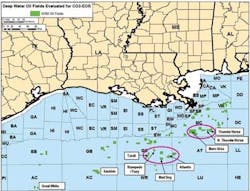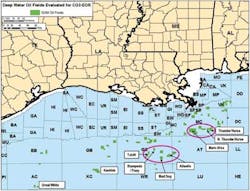Using CO2 extends range of EOR applications for GoM operators
Offshore Staff
Houston
The use of CO2 enhanced oil recovery (CO2-EOR) in the Gulf of Mexico (GoM) can offer significant benefits to offshore operators. These include increased domestic oil production and federal revenues; a market for CO2 emissions captured from electric power and industrial plants along the Gulf Coast; and secure CO2 storage located away from population centers.
For the mature GoM oil fields in the shallow waters (less than 1,000 ft of water depth), there is considerable urgency for using CO2-EOR before these fields are abandoned and their platforms removed. A number of older deepwater oil fields are also nearing maturity and face similar abandonment issues.
For the newly discovered oil fields in the deepwaters of the GoM, there is an opportunity to apply CO2-EOR early in the life of these large fields, improving their economic viability and their availability for storing CO2.
Click image to Enlarge
In June, the National Energy Technology Laboratory (NETL), a division of the US Department of Energy, released "CO2-EOR Offshore Resource Assessment." The report, authored by Taylor Malone and Vello Kuuskraa of Advanced Resources International Inc., and Phil DiPietro of NETL, analyzes the economic and technical factors relating to the use of CO2-EOR offshore in the Gulf of Mexico.
The report found the economic viability of CO2-EOR in the GoM depends greatly on three factors: the price of oil, the cost of CO2, and the efficiency of CO2-EOR technology. As it now stands, the price of oil is the constraining factor. Assuming a price recovery in the near to medium term, this study provides a variety of sensitivity analyses that examine how these three factors affect the results of the GoM CO2-EOR resource assessment.
This assessment of GoM outer continental shelf (OCS) oil fields also considers: when in the life of the oil field the CO2 flood is initiated; how well developed and drilled is the oil field at the time of CO2-EOR implementation; what are the water and reservoir depths; and how much oil remains after primary/secondary oil recovery. In general, shallow-water oil fields have high (40% to 60%) oil recovery efficiencies. In contrast, deepwater oil fields have much lower recovery efficiencies and thus have considerably larger remaining oil volumes as the target for CO2-EOR.
This analysis incorporates considerations of oil field maturity and development status, water and reservoir depth, and oil recovery efficiency into a GoM offshore oil field/reservoir database and into the calculations of expected CO2-EOR performance and development costs. The assessment evaluated 60 deepwater GoM oil fields as well as the clusters of "anchor fields" (oil fields with more than 1 Bbbl of original oil in-place) that would be the destination of potential CO2 pipelines.
Resource assessment
The CO2-EOR assessment for the GoM OCS starts with a base case that assumes: (1) an oil price of $90/bbl; (2) CO2 costs of $50/metric ton (mt), delivered to the oil field at pressure (CO2 purchase price of $30/mt (at plant gate), and $20/mt for offshore transportation); and (3) current CO2-EOR technology. The study then examines how use of "next generation" CO2-EOR technology would impact the offshore GoM resource assessment.
Current technology
In the base case, the GoM OCS offers relatively modest oil recovery and CO2 storage opportunities from the application of CO2-EOR – 810 MMbbl of incremental oil and 310 million metric tons (MMmt) of CO2 demand and storage. However, lower CO2 costs and higher oil prices would improve the results while lower oil prices and higher CO2 costs would worsen results.
One important consideration exists when assessing GoM OCS CO2-EOR; is there enough CO2 available in the Gulf Coast area for large-scale implementation of CO2-EOR? The available natural (geologic) CO2 supplies along the Gulf Coast are limited and already committed to onshore CO2-EOR projects. As such, the use of CO2-EOR offshore in the GoM would need to rely on CO2 captured from power and other industrial plants.
Analysis by the US DOE/National Energy Technology Laboratory shows that 94 MMmt/yr of CO2 is currently vented from large (more than 3 MMmt/yr) power and industrial plants along the Gulf Coast. With an EOR demand (under current CO2-EOR technology) for CO2 of 310 MMmt over a 30-year time period, about 10 MMmt/yr (0.5 bcf/d) would be required. This represents only a fraction of the annual CO2 emissions from large point sources in the Gulf Coast area, primarily petroleum refineries (45 MMmt/yr), fossil fuel power plants (41 MMmt/yr), and other industrial facilities (8 MMmt/yr).
Displaying 1/2 Page 1,2Next>
View Article as Single page

